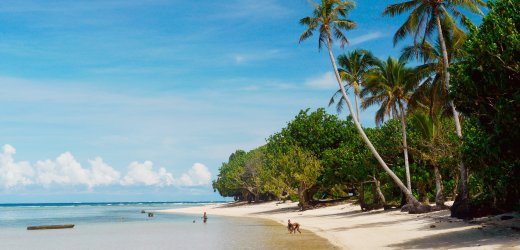October 18, 2014 – Think about it. Why would a small island nation that gets 300+ sunny days a year and fairly constant ocean winds import coal, oil, diesel or liquid natural gas to provide power to its citizens? Why would island nations of volcanic origin with active and passive geothermal capacity not be harvesting these resources rather than burning fossil fuels? And finally, why wouldn’t small island nations surrounded by seas and oceans not embrace tidal and wave power? It seems intuitive but not the reality for many small island nations today even though they are the planet’s most susceptible countries in the face of atmospheric warming and global climate change.
In September of this year the United Nations sponsored a conference in Samoa that invited small island developing states, commonly called SIDS, to talk about their particular vulnerabilities in the 21st century and what actions they needed to take. There are a lot of SIDS, 39 in total. They are found in all the major temperate and tropical oceans and seas on the planet. From success stories like Singapore to nations in peril like Kiribati, they cover a wide range of cultures and economic models.
Some SIDS have adopted renewable energy and a strategy of net carbon neutrality. Among these the Seychelles, Maldives, Tuvalu and several Caribbean islands. Tokelau in the Pacific is the first SIDS to go 100% solar. So if these SIDS can do it why not all?
One of the reasons they can’t is size. Small has disadvantages. Small often means a lack of sufficient tax base or capital to implement infrastructure projects such as converting from coal or oil-fired power plants to 100% renewables.
SIDS are often remote from producers of the technologies they would want to install. This means added freight and transportation costs.
SIDS may not have the necessary education and skill sets to draw upon from within the country to support the move away from fossil fuels to renewables.
So money, isolation and education are among the many challenges that need to be addressed to achieve a successful transition.
Despite the impediments some SIDS are moving ahead with the conversion. Take for example Turks and Caicos who in March of this year began installing 141 grid-tied solar photovoltaic panels as the first stage in a country-wide implementation. A third-party supplier, UGE (Urban Green Environmental) designed, implemented and installed the project working with a local company, Fortis TCI, so that knowledge transfer would occur. The initial success of this installation means Turks and Caicos will further commit to transitioning from fossil-fuel power sources to renewables with local expertise trained and ready to scale the conversion for the entire country.
At the conference in Samoa attended by 45 countries, leaders from SIDS and other attending nations signed a treaty to commit to making sustainable, renewable energy available to the 20 million who live on small islands. The goal of the agreement to totally transform SIDS economies to a low carbon future. Denmark, Japan, Austria, the World Bank, the Clinton Foundation and offices of the United Nations witnessed the signing and pledged their support to fulfill this goal. A number of SIDS are on target to 100% renewable energy by 2020 and they are committed to making the transition with far fewer resources than most nations in the Developed World. Food for thought!


















